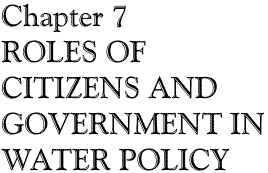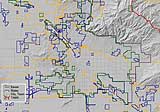
| ch. 7, pp. 105 - 107 |
Tucson Xeriscape Ordinance This ordinance applies to new multifamily, commercial and industrial developments. Its goal is to conserve water by applying xeriscape principles. These principles include using drought-tolerant plants, maintaining limited grass areas and applying mulch and soil improvements. Landscaped areas must be designed to take advantage of storm water run-off, and water-conserving irrigation systems are required. City and County Plumbing Codes Both city and county require that water-efficient fixtures be used in all new residential and commercial construction. Toilets must be ultra-low flush (i.e., 1.6 gallons per flush or less) and faucets must not exceed 2.5 gallons per minute. The code also applies to replacement of old fixtures. Requirements also are established for evaporative coolers, air conditioners, decorative fountains and waterfalls. Water Waste Ordinance Since 1984 it has been illegal for people within the City of Tucson to let water flow off their property onto public areas or other property. A “water cop” can fine individuals, property managers and landscape contractors who are guilty of this infraction. Tampering with water meters also is illegal. Golf Course Water Use Tucson and Pima County have ordinances requiring the use of CAP or effluent for new golf courses where feasible. (See Chapter 5 for more information.) Emergency Water Conservation Upon declaring a water emergency because of problems with water supply, the Tucson City Council may prohibit or restrict non-essential uses of water. Examples of restricted activities are outdoor irrigation except areas using reclaimed water, washing of sidewalks, outdoor water-based play, automatic water service in restaurants, misting systems, filling swimming pools and spas, and washing of vehicles except at facilities with recirculation systems. Exceptions can be allowed for reasons of public health, safety or economic hardship. Tucson operates the largest water system in the area, serving about 600,000 persons an average of about 97 million gallons of water daily. The city serves customers both inside and outside city limits. Since Tucson Water is managed by the Tucson City Council, people who are not city residents have little say on city water decisions, even though they receive city water. Approximately 16 other water providers serve another 155,000 customers in the area. The remaining 81,000 water users are served by very small water companies or have their own wells. Some of these water companies are within the city limits of Tucson, Oro Valley or Marana. The cities do not regulate the activities of these water providers and cannot require their compliance in such activities as water conservation programs. Water providers that are not municipal water departments, on the other hand, have little or no say in certain city decisions that affect them, such as rezonings and conservation ordinances. ACC regulates rates and some procedures of private water companies, but not municipal utilities or irrigation districts. ADWR can require all three types of water utilities to implement conservation measures and meet sustainability goals but has no jurisdiction over water users themselves. At times, ACC and ADWR rules conflict. Pima County handles most wastewater in the region, with treatment plants at Roger Road and Ina Road, next to the Santa Cruz River. Pima County also runs several small treatment plants outside the metropolitan area. Because of an intergovernmental agreement between Tucson and Pima County, Tucson has rights to most of the effluent that comes from wastewater treatment facilities throughout Pima County. A few neighborhoods have their own treatment facilities, and some people have septic tanks or other kinds of individual treatment systems. Some subdivisions with golf courses, such as El Conquistador, use treated water from their local community for watering the golf course.
Despite, or perhaps because of the many laws and rules, no one agency has legal authority to coordinate water use area-wide. This is to the detriment of efficient water management. TAMA and the Pima Association of Governments (PAG), however, address some basin-wide issues that were previously discussed. The following further characterizes water management in the Tucson area:
|

